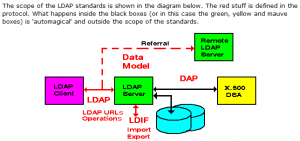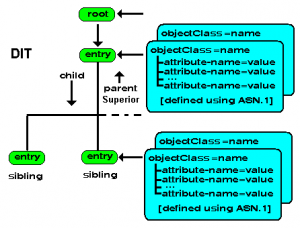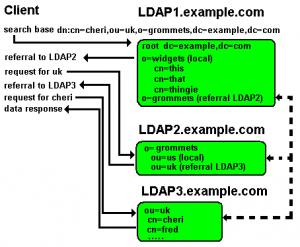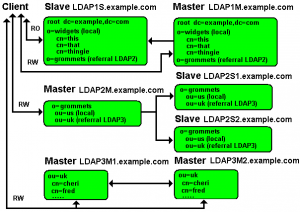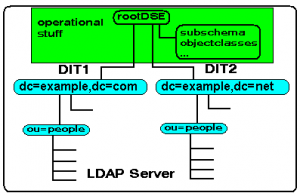Contents
Overview
* LDAP defines a protocol for
– accessing directory data
– representing data in directory service
– imp/exp data in directory service (ldif format)
* LDAP does not define
– how data is stored
– how data is manipulated
Four Models (FINS)
* Functional model: how to access LDAP
* Information Model: how to represent information aka data (not how to store data)
* Naming model: for example, dc=example,dc=com
* Security model:
LDAP Advantages
* Write-once-read-many-times
* Standardized method for local as well as remote ldap access
– Data can be delegated to multiple locations
* Can be configured to replicate data (like DNS)
LDAP Disadvantages
* Updates are expensive (due to indexing)
* Not for transaction activities (may contain data inconsistencies)
Object or Data Model
Data Information Tree (DIT)
* LDAP represents data as a hierarchy of objects, like a tree:
– has a root
– has branches (entries)
– has leaves (objectClasses)
– each leave (i.e. objectClass) has cells (attributes)
– cell (i.e. attribute) is where data is stored
Schema
* Convenient packaging unit for a group of objectClasses and attributes
* Think of it as different type of trees such as oak tree, willow tree, fir tree, etc.
Entries
* Must contain one, and only one, STRUCTURAL objectClass
* May contain one ABSTRACT objectClass
* May contain any number of AUXILIARY objectClasses
* May have parent, and/or child, and/or sibling entries
ObjectClass
* Used as a container for attributes
* Has a OID
* Has a name
* Is searchable
* Defines if an attribute is optional or mandatory
* Can be part of hierarchy:
– the whole hierarchy must be of the same type, i.e. STRUCTURAL or AUXILIARY
– inherits all characteristics of its parent ObjectClasses
ObjectClassDescription = "(" whsp numericoid whsp ; ObjectClass identifier [ "NAME" qdescrs ] [ "DESC" qdstring ] [ "OBSOLETE" whsp ] [ "SUP" oids ] ; Superior ObjectClasses [ ( "ABSTRACT" / "STRUCTURAL" / "AUXILIARY" ) whsp ] ; default structural [ "MUST" oids ] ; AttributeTypes [ "MAY" oids ] ; AttributeTypes whsp ")"
Attribute
* Has a OID
* Has a name
* Is searchable
* May be part of hierarchy
– inherits all properties of its parents
* Can have aliases or abbreviations, e.g. cn for commomName
* Usually contains data
– has a data type
– defaults to allow multiple values
* Always associated with one or more ObjectClasses
* Can be either optional or mandatory for associated ObjectClass
* No primary key, one or more attributes are used to identity a unique entry. Like database combination keys and are called naming attributes or relative distinguished name (RDN) in LDAP.
AttributeTypeDescription = "(" whsp numericoid whsp ; AttributeType identifier [ "NAME" qdescrs ] ; name used in AttributeType [ "DESC" qdstring ] ; description [ "OBSOLETE" whsp ] [ "SUP" woid ] ; derived from this other ; AttributeType [ "EQUALITY" woid ; Matching Rule name [ "ORDERING" woid ; Matching Rule name [ "SUBSTR" woid ] ; Matching Rule name [ "SYNTAX" whsp noidlen whsp ] ; see section 4.3 [ "SINGLE-VALUE" whsp ] ; default multi-valued [ "COLLECTIVE" whsp ] ; default not collective [ "NO-USER-MODIFICATION" whsp ]; default user modifiable [ "USAGE" whsp AttributeUsage ]; default userApplications whsp ")"
LDAP Referrals
* Similar to DNS referrals in concept
* No server auto referrals defined in standards
– Some vendors, e.g. OpenLDAP, use chaining for auto referrals
* Referrals are returned to client instead
LDAP Replication
* Built in replication to allow one or more copies of DIT (not whole LDAP) to be slaved from a single master
* Takes time to replicate (potential data inconsistencies)
* Master-Slave replication:
– slaves are read only copies of the master
– master server is single point of failure
* Multi-Master replication:
– Data contentions: value contention and delete convention
* Example replication configurations:
Matching Rules
* Part of LDAP operational
* Typicall built-in to the LDAP server and defined in subschema
* A matching rule is defined for each attribute using
– EQUALITY
– SUBST
– ORDERING
Operational Attributes and Objects
* Build in attributes and objectClasses
* Governs how LDAP server functions
* Live under rootDSE
* Not visible during normal operations
* From ldapsearch:
# note the + returns operational attributes ldapsearch -h localhost -p 1389 -x -s base -b "" +
References
* LDAP for Rocket Scientists
* OpenLDAP Glossary
* RFC 2252: Lightweight Directory Access Protocol (v3): Attribute Syntax Definitions

